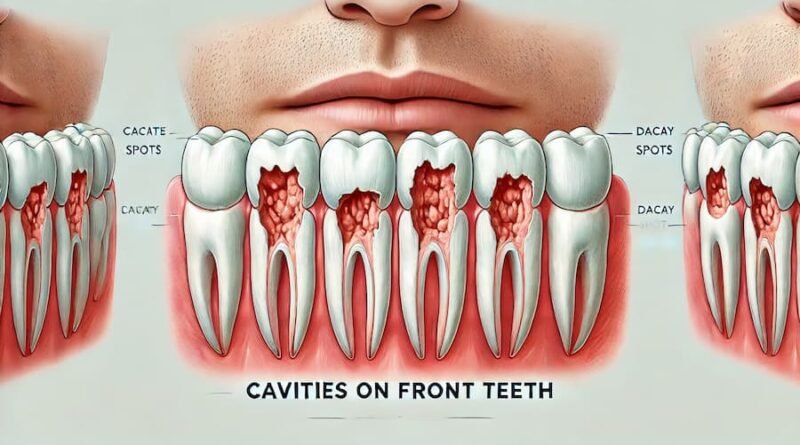How to Treat Cavities on Front Teeth Effectively
Key Takeaways
- Catching cavities on your front teeth early and treating them right away is key to preventing bigger problems.
- You’ve got options—fluoride treatments, fillings, bonding, veneers, and root canals, depending on what your tooth needs.
- How your teeth look matters, so choosing the right cosmetic approach is important when treating front teeth.
- Daily oral hygiene and regular dental check-ups can keep those pesky cavities at bay.
- Natural remedies can support dental health, but they’re no substitute for professional care.
Introduction
When it comes to our front teeth, keeping them healthy isn’t just about looking good—it’s about feeling good too. Our smiles say so much about us, and having strong, healthy front teeth can really boost our confidence. Cavities on these teeth can be a real downer, not just because they hurt, but because they’re out there for the world to see. I’ve seen firsthand how a little spot on a front tooth can turn into a big issue if it’s not dealt with early. That’s why I’m here to share some of the best ways to treat cavities on front teeth, so you can keep smiling without a second thought.
Understanding Cavities on Front Teeth
What Causes Cavities on Front Teeth?
Cavities, or dental caries, are what happens when your tooth enamel gets worn down by acids. These acids come from bacteria that love to feast on the sugary stuff we eat and drink. I’ve noticed that even with the best intentions, those sugary snacks can sneak up on you, and before you know it, you’ve got a cavity starting to form.
How Cavities on Front Teeth Differ from Those on Other Teeth
Cavities on front teeth are a bit of a double whammy—they’re more noticeable because these teeth are what everyone sees when you smile, and because of that, the pressure to keep them looking good is high. Treating these cavities often means balancing effective care with cosmetic concerns, which can be tricky but absolutely worth it.
Symptoms and Early Signs to Watch Out For
Look out for white spots, sensitivity, or any little holes or discoloration—these are usually the first signs that something’s up. These are the little red flags your teeth throw up, and trust me, the sooner you tackle them, the less hassle you’ll face later on.
Risk Factors for Developing Cavities on Front Teeth
Poor Oral Hygiene Habits
It’s easy to let good habits slide, but skipping brushing or flossing can lead to plaque buildup, and trust me, that’s the first step toward cavities.
Diet and Sugar Intake
We all have our weaknesses—mine used to be sugary drinks—but cutting back on sugar has made a world of difference in my dental health.
Genetic Predisposition
Some of us are more prone to cavities than others, and it might not be entirely our fault. If you’ve ever felt like you’re doing everything right and still getting cavities, genetics could be playing a role.
Impact of Lifestyle Choices (e.g., Smoking, Alcohol)
Smoking and alcohol don’t just mess with your overall health—they dry out your mouth and make it easier for cavities to form. Making healthier choices can have a big impact on your teeth.
Diagnosis of Cavities on Front Teeth
Role of Dental Exams and X-rays
Regular dental check-ups have been a game-changer for me. They’re not just about keeping your teeth clean—they’re about catching issues like cavities before they become visible problems.
Importance of Early Detection
I’ve learned the hard way that early detection is key. The sooner you catch a cavity, the less invasive and less expensive the treatment tends to be.
How Dentists Identify Cavities on Front Teeth
Your dentist has a few tricks up their sleeve for finding cavities early, from visual exams to X-rays, and even specialized tools that can spot trouble before it gets serious. I’ve found that asking questions during these exams can really help you understand what’s going on.
Treatment Options for Cavities on Front Teeth
Fluoride Treatments
- How Fluoride Helps in Early-Stage Cavities: Fluoride treatments are like magic for your teeth. They actually help rebuild the enamel and can even reverse the damage if you catch it early.
- Professional Fluoride Treatments vs. At-Home Products: While I keep a fluoride toothpaste at home, I’ve found that professional treatments at the dentist’s office provide a much-needed boost, especially if you’re at high risk for cavities.
Dental Fillings
- Types of Fillings Suitable for Front Teeth: When I had a cavity on a front tooth, I opted for a composite resin filling. It blends in perfectly with my natural tooth color, so no one can tell it’s there.
- The Procedure and What to Expect: It’s pretty simple—your dentist numbs the area, clears out the decay, and fills the cavity. Quick and easy!
Dental Bonding
- When is Bonding Recommended?: If your cavity is small or you’ve chipped a front tooth, bonding might be your best bet. It’s a quick, painless procedure, and the results are aesthetically pleasing.
- Advantages of Bonding for Aesthetic Purposes: I once had a small chip on a front tooth, and bonding was a perfect solution. It restored the tooth’s appearance without the need for more invasive procedures.
Veneers for Severe Cases
- How Veneers Can Cover and Protect Damaged Teeth: For those who have more extensive damage, veneers might be the way to go. I’ve seen veneers transform smiles, covering up damage while providing a fresh, new look.
- Procedure Overview and Longevity: Veneers require removing a bit of enamel and bonding a thin shell to your tooth. They’re durable and, from what I’ve seen, can last for many years if you take good care of them.
Root Canal Therapy
- When is a Root Canal Necessary?: I’ve always tried to avoid root canals by catching cavities early, but if the decay reaches the pulp, a root canal might be the only way to save the tooth.
- Steps Involved in Root Canal Treatment for Front Teeth: The process sounds daunting, but in reality, it’s quite routine. The infected pulp is removed, the canal is cleaned, and the tooth is sealed—often with a crown placed on top to protect it.
Crowns for Front Teeth
- Why Crowns Might Be Needed: Sometimes, a filling isn’t enough, and a crown is necessary to restore both function and appearance. I’ve seen how crowns can save a severely damaged tooth while keeping your smile intact.
- Material Choices and How They Affect Appearance: If you need a crown on a front tooth, go for materials like porcelain or ceramic that match the natural color of your teeth. I recommend discussing these options with your dentist to find the best fit.
Pain Management During and After Treatment
Local Anesthesia and Sedation Options
Numbing the area with local anesthesia usually does the trick, but if you’re feeling nervous, don’t hesitate to ask about sedation. There’s no need to tough it out.
Post-Treatment Pain Relief Strategies
After my last filling, I followed my dentist’s advice—used an ice pack and took over-the-counter pain relievers. It made a huge difference in my recovery.
Tips for Reducing Discomfort During Recovery
Stick to soft foods, avoid extreme temperatures, and keep up with your oral hygiene. These simple steps helped me bounce back quickly after treatment.
Cosmetic Considerations for Treating Front Teeth
Matching Fillings to the Natural Tooth Color
It’s super important to make sure your filling matches your natural tooth color—I always stress that.
Options for Maintaining or Enhancing the Appearance of Front Teeth
If you’re concerned about the appearance of your front teeth after treatment, consider options like veneers or bonding. I’ve recommended these to friends who were thrilled with the results.
How to Discuss Cosmetic Concerns with Your Dentist
Don’t hesitate to talk to your dentist about your cosmetic concerns. I’ve found that being upfront about your expectations helps ensure you get the results you want.
Preventive Measures to Avoid Cavities on Front Teeth
Daily Oral Hygiene Routine
- Importance of Brushing and Flossing Correctly: I can’t stress enough how important it is to brush and floss daily. It might seem basic, but this routine is your first line of defense against cavities.
- Role of Mouthwash in Preventing Cavities: Adding an antimicrobial mouthwash to your routine can make a big difference. I’ve noticed fewer issues since incorporating it into my daily regimen.
Dietary Changes
- Foods to Avoid and Those That Promote Dental Health: Honestly, cutting back on sugar made a huge difference for me. Instead, I focus on foods that promote dental health, like crunchy vegetables and dairy products rich in calcium.
- Impact of Reducing Sugar Intake: Reducing sugar doesn’t just help prevent cavities—it’s made my whole mouth feel healthier.
Regular Dental Check-ups
- Frequency of Visits for Optimal Oral Health: I make it a point to visit my dentist every six months. These regular check-ups have been invaluable in catching problems early.
- Preventive Treatments Available During Check-ups (e.g., Sealants): During my check-ups, my dentist has recommended sealants to protect my teeth from decay, especially in the hard-to-reach areas.
Home Remedies and Natural Treatments
Are There Effective Home Remedies for Cavities?
While I’m all for natural health remedies, I’ve learned that they should complement, not replace, professional care. For example, oil pulling with coconut oil has been part of my routine, but I don’t rely on it to fix cavities.
Natural Products That Support Dental Health (e.g., Coconut Oil, Xylitol)
Coconut oil and xylitol have been great additions to my oral care routine. They help reduce harmful bacteria, but I still prioritize regular brushing, flossing, and professional cleanings.
Risks Associated with DIY Treatments
DIY treatments can be tempting, but they come with risks. I’ve always found it better to consult with a dentist before trying something new, especially when it comes to cavities.
Pediatric Considerations: Treating Cavities on Children’s Front Teeth
Unique Challenges in Treating Cavities in Young Children
Treating cavities in kids is challenging—they’re often scared or nervous, and their teeth are still developing. I’ve seen firsthand how important it is to make the experience as positive as possible.
Child-Friendly Treatment Options
Fluoride treatments and tooth-colored fillings are great options for kids. They’re effective and help keep their smile looking natural, which is important for their self-esteem.
Importance of Teaching Good Dental Habits Early
I’ve always believed in starting good dental habits early. Teaching kids how to brush and floss properly can prevent cavities and set them up for a lifetime of good oral health.
Case Studies: Successful Treatment of Cavities on Front Teeth
Case Study 1: Early Detection and Treatment with Fluoride
I remember a time when I noticed a small white spot on one of my front teeth. My dentist recommended a professional fluoride treatment, and it worked wonders, reversing the early-stage cavity without needing a filling.
Case Study 2: Dental Bonding for a Chipped Front Tooth with Cavity
A friend of mine chipped a front tooth that also had a small cavity. She opted for dental bonding, and the result was fantastic—the tooth looked good as new, and she couldn’t stop smiling.
Case Study 3: Root Canal and Crown for a Severely Decayed Front Tooth
Another case involved a severely decayed front tooth that required a root canal and a crown. While the procedure was more involved, the outcome was a fully functional and natural-looking tooth that the patient was extremely happy with.
Conclusion
At the end of the day, the best way to deal with cavities is to stop them from happening in the first place. Treating cavities on front teeth effectively requires a combination of early detection, appropriate treatment, and preventive care. Based on my experiences, maintaining a diligent oral hygiene routine and seeking regular dental check-ups are crucial steps to protect your front teeth from decay and keep your smile looking its best.
Frequently Asked Questions (FAQs)
What Are the First Signs of a Cavity on a Front Tooth?
Look out for white spots, sensitivity, or any little holes or discoloration—these are usually the first signs that something’s up. I’ve learned to watch for these signs and act quickly to prevent further damage.
How Long Does It Take to Treat a Cavity on a Front Tooth?
Treatment time varies depending on the severity but typically ranges from 30 minutes to an hour for fillings. I’ve found that the process is usually quicker and less painful than most people expect.
Can a Cavity on a Front Tooth Heal on Its Own?
No, cavities cannot heal on their own. Early-stage cavities may be reversed with fluoride, but more advanced decay requires professional treatment. Based on my experience, it’s better to address the issue sooner rather than later.
What Are the Best Preventive Measures for Cavities on Front Teeth?
To prevent cavities on front teeth:
- Maintain a consistent oral hygiene routine: Brush twice daily with fluoride toothpaste and floss regularly.
- Limit sugary foods and drinks: Reducing sugar intake minimizes the food source for cavity-causing bacteria.
- Visit your dentist regularly: Regular check-ups allow for early detection and professional cleanings, which are crucial in preventing cavities.



